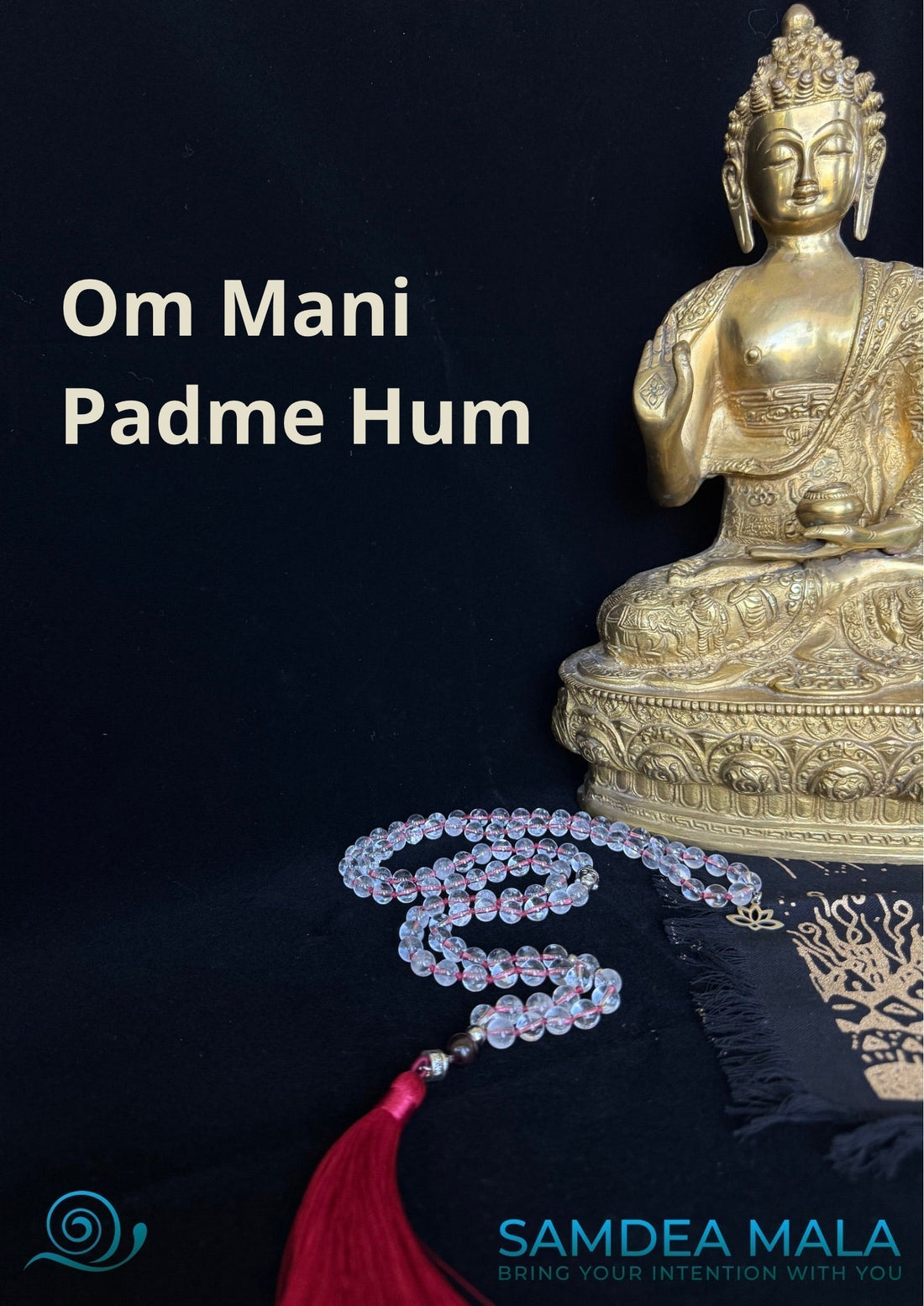
Om Mani Padme Hum — The Mantra of Universal Compassion
Share
The sacred mantra Om Mani Padme Hum, often called “The Six-Syllable Mantra,” is one of the most powerful and widely recited chants in Tibetan Buddhism and yoga traditions.
It is a vibration of compassion, meant to purify the mind, open the heart, and bring peace — both within and beyond.
Unlike other mantras, it does not refer to a divine being, but to a jewel within the lotus, a symbol of the inner beauty that remains untouched by the mud of life.
As His Holiness the Dalai Lama says, “its meaning is vast and profound,” because it holds within it the essence of the entire Buddhist path.
The Meaning of the Syllables
Each syllable of Om Mani Padme Hum holds a sacred vibration and symbolic power:
Om – the sound of the universe, the primordial vibration
Mani – means “jewel,” representing altruistic intention and the aspiration to benefit all beings
Padme – means “lotus,” symbolizing wisdom that arises from experience
Hum – represents the indivisibility of method and wisdom, compassion and insight
In Tibetan Buddhist philosophy, the six syllables also correspond to six realms of existence and are said to purify the emotional patterns associated with them.
A Healing Practice for the Present
Chanting Om Mani Padme Hum is not just a path to future merit — it’s a practice of clearing the mind and heart in the here and now.
It helps soothe the senses, restore energy to unbalanced chakras, and bring calm awareness into the body.
When chanted in groups, this mantra becomes even more powerful — uniting voices in a shared intention for healing, connection, and compassion.
✨ Benefits of Reciting This Mantra
Clears the mind and helps release ego attachment
Purifies karmic imprints that hold you back
Sends a clear message to yourself and the universe about the kind of person you want to become
Empties the body of tension and restores inner clarity
This is why so many practitioners believe Om Mani Padme Hum is the most powerful of all yogic chants.
A Mantra Beyond Borders
Though deeply rooted in Tibetan Buddhism, this mantra has been embraced by other spiritual paths, including Hinduism, yoga, and even non-religious meditation communities.
Its vibration has crossed cultural boundaries, reminding us that peace and compassion are universal desires — beyond dogma or belief.

A Mystical Legacy: The Black Hat Ceremony
Centuries ago, a Tibetan king dreamed of the Karmapa — the head of the Karma Kagyu lineage — wearing a black hat encrusted with jewels.
In the dream, the Karmapa placed the hat on his head, took a crystal mala, and began to chant Om Mani Padme Hum.
A radiant light surrounded him, and all present entered an exalted state of awareness.
The king had the hat crafted and gifted it to the Karmapa, who accepted it and initiated what became the legendary Black Hat Ceremony.
The Symbolism of the Black Hat
In this rare ritual:
The Karmapa wears the Black Crown
He holds a clear quartz mala
He recites the mantra 108 times, blessing everyone present
The Black Hat represents the enlightened mind of the Karmapa, the realization of emptiness united with compassion, and protection from illusion and confusion
According to legend, it is not made only of fabric and stones — but of karmic merit woven by a thousand dakinīs, enlightened feminine beings.
Is the Ceremony Still Performed?
In the past it was performed rarely, often during travels or specific occasions. The last public performance was by the 16th Karmapa, Rangjung Rigpe Dorje, in the 1970s–80s.
Today the current 17th Karmapa has not performed it publicly, due to political and spiritual complexities. There are two claimants to the title, and the ceremony remains highly esoteric.
The hat is also known as:
The Crown of Liberation
The Hat that Subdues the Demons of Illusion

Your Mala for the Mani
To chant this mantra with full presence, you can use a 108-bead mala made of clear quartz, the traditional material used in Tibetan rituals.
Each bead becomes a breath, a step, a whisper of the sacred — bringing you closer to the jewel in your heart.
A Samdea Mala crafted for Om Mani Padme Hum is intentionally designed and knotted by hand with care. Before reaching you it is blessed with silence, breath, and intention, because this mantra is not just recited — it is lived.
Final Reflection
Whether whispered alone at dawn or chanted aloud in community, Om Mani Padme Hum connects you to something vast, ancient, and deeply human:
The wish that all beings may be free from suffering, and that peace may begin inside us.
Bring Your Intention With You.
Let your voice join the stream of compassion that has echoed through centuries — and still lives in every breath.


